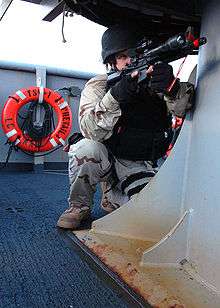Prevail (IX-537)
Prevail (IX-537) is a modified Stalwart-class auxiliary general ocean surveillance ship (AGOS) of the United States Navy previously operated by the U.S. Military Sealift Command as T-AGOS 8. Prevail was reclassified as Unclassified Miscellaneous (IX) in October 2003 and is unofficially referred to as TSV-1. In this context, TSV stands for Training Support Vessel, and should not be confused with the U.S. Army's USAV Spearhead Theater Support Vessel initiative.
_underway_in_the_Atlantic_Ocean_on_14_November_1986_(6416390).jpg) USNS Prevail (T-AGOS-8), 1986 | |
| History | |
|---|---|
| Awarded: | 13 February 1981 |
| Builder: | Tacoma Boatbuilding Company |
| Laid down: | 13 March 1985 |
| Launched: | 7 December 1985 |
| In service: | 4 March 1986 |
| Reclassified: | IX-537 17 October 2003 |
| Identification: |
|
| Status: | in active service |
| General characteristics | |
| Class and type: | Stalwart-class ocean surveillance ship |
| Displacement: | 1,565 tons (light) 2,535 tons (full) |
| Length: | 224 ft (68 m) |
| Beam: | 43 ft (13 m) |
| Draft: | 15 ft (4.6 m) |
| Speed: | 11 knots (20 km/h; 13 mph) |
| Complement: | 33 |
Prevail is currently assigned to Commander, Carrier Strike Group Four and is operated with a minimal, hybrid crew of civil service and contract mariners. The ship provides a dedicated training support for Strike Group training for U.S. Atlantic Fleet ships, including serving as a platform for training Visit, Board, Search, and Seizure (VBSS) operations.
Stalwart-class ships were originally designed to collect underwater acoustical data in support of Cold War anti-submarine warfare operations in the 1980s.

Design
The Stalwart-class ocean surveillance ships were succeeded by the longer Victorious-class ocean surveillance ships. Prevail had an overall length of 224 feet (68 m) and a length of 203 feet 6 inches (62.03 m) at its waterline. It had a beam of 43 feet (13 m) and a draft of 15 feet (4.6 m). The surveillance ship had a displacement of 1,600 tonnes (1,600 long tons; 1,800 short tons) at light load and 2,301 tonnes (2,265 long tons; 2,536 short tons) at full load. It was powered by a diesel-electric system of four Caterpillar D-398 diesel-powered generators and two General Electric 550 metric horsepower (540 shp; 400 kW) electric motors. This produced a total of 3,200 metric horsepower (3,200 shp; 2,400 kW) that drove two shafts. It had a gross register tonnage of 1,584 and a deadweight tonnage of 786.[1]
The Stalwart-class ocean surveillance ships had maximum speeds of 11 knots (20 km/h; 13 mph). They were built to be fitted with the Surveillance Towed Array Sensor System (SURTASS) system. The ship had an endurance of thirty days. It had a range of 3,000 miles (2,600 nmi; 4,800 km) and a speed of 11 knots (20 km/h; 13 mph). Its complement was between thirty-two and forty-seven. Its hull design was similar to that of the Powhatan-class fleet ocean tugs.[1]
References
- This article includes information collected from the Naval Vessel Register, which, as a U.S. government publication, is in the public domain. The entries can be found here and here.
- Solicitation notice - USNS PREVAIL (TSV-1), PMF, SSP-501-06
- Ex-USNS Prevail takes on new role for Navy. December 2003.
- Norman Polmar (2005). The Naval Institute Guide to the Ships and Aircraft of the U.S. Fleet. Naval Institute Press. p. 617. ISBN 978-1-59114-685-8.
External links

- Photo gallery of Prevail (IX-537) at NavSource Naval History